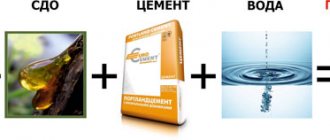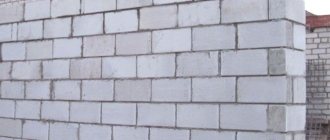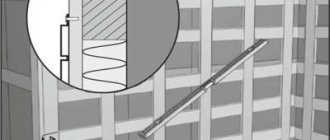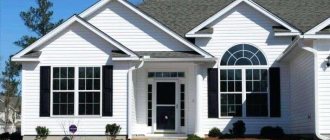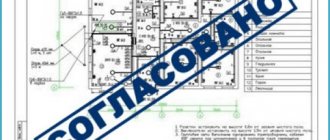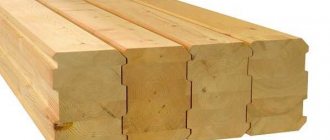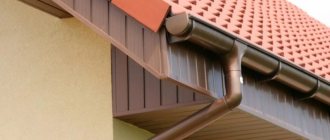When choosing concrete or cement, buyers focus primarily on the brand or strength class.
The grade strength provided for by GOSTs implies division into grades (m-200, m-300, etc.), thus indicating the compressive strength in kgf/sq. cm.
Strength classes (b-15, b-22.5, etc.) mean almost the same thing, but with minor nuances. For more detailed information on the classification of concrete, see the section classes and grades of concrete.
For foam concrete blocks, only one of these parameters is important - the strength class. Despite the most important importance of the strength class of the wall material, on which the integrity and durability of the entire structure being built depends, manufacturers and buyers of foam concrete blocks most often mention another parameter - the density of the foam block. The density of foam concrete is designated letter D with a digital density value in kg per cubic meter. m. That is, the density of foam concrete D600 indicates that a cubic meter of such foam concrete weighs 600 kilograms (subject to a certain humidity). It would seem, what difference does it make how many kilograms a cube of foam concrete weighs?
Well, it weighs 600 and that’s good, 800 weighs not bad either. This is not a foundation block of concrete, which with a similar size would weigh two and a half tons. For the load on the foundation and floor, the density of foam concrete is not critical. Foam concrete, like all lightweight concrete, is valued mainly not for its lightweight qualities. Its main task is to ensure minimal thermal conductivity (maximum thermal insulation) of walls, while maintaining the necessary strength of the entire wall structure.
This is where the main compromise between strength and thermal insulation lies. As an example, we present a table that compares all the main characteristics of foam blocks. The main purpose of the foam block Density of the foam block Strength class VA Similar grade of concrete Thermal conductivity coefficient Frost resistance coefficient FT Thermal insulation contour of the walls D400B0.75M-100.09-0.10 D500B1M-150.10-0.12 Load-bearing and thermal insulation foam block D600B2 ,5M-350.13-0.14F15-F35D700B3.5M-450.15-0.18F15-F50D800B5M-600.18-0.21F15-F75D1000B7.5M-1000.23-0.29F15-F50 Load-bearing walls D1100B10M-150 0, 26-0.34 D1200B12.5M-1500.29-0.38 As you can see, as the density of the foam block increases, its strength and thermal conductivity increases. And if there is no such thing as excessive strength, then in the case of thermal conductivity everything is different.
A higher coefficient of thermal conductivity indicates that the material retains heat less well and also poorly resists the cold acting on the walls of your house from the street. When the density of foam concrete decreases, the thermal insulation characteristics improve, but the load-bearing capacity of the walls made of foam blocks also decreases proportionally. The warmer the foam block, the less load it can withstand. It is interesting to compare the strength of foam blocks with the strength of classic building concrete. As you can see in the table, the grade strength of a standard foam block with a density of D600 is only M-35 (class B2.5), which is almost ten times less than the grade of concrete that was used to pour your foundation (for example, the same concrete M350).
Knitting
The binding component is lime, Portland cement is the main substance used by builders for the construction of any object. Complies with GOST 10178-85.
Return to contents
Cement
Portland cement hardens under the influence of water and air. It is a composition of limestone and clay, which were initially fired. After sintering the mixture is enriched with calcium silicate. The quality of clinker - granules of the mixture, affects the strength, stability, and durability of the structure. Gypsum is added to it, which allows you to control the setting period of standard cement.
Portland cement is divided into 3 types:
- D0 – no additives;
- D5 – mixtures have less than five percent active mineral additives;
- D20 - the amount of additives varies from five to twenty percent, including 10% additives - minerals of hydraulic origin.
The grade of cement used for foam concrete has a density of 500 kg/m3, 400 kg/m3 with zero impurities. Sometimes they use a grade of 400 - 500, the additives of which are more than 5%.
Return to contents
Lime
Sometimes the main binding component is lime. The use of lime depends on the manufacturing technology of cellular concrete. Basic requirements for the substance: uniform firing, total activity above 75%, magnesium content less than one and a half percent. The total activity of lime is determined by the amount of active oxides of calcium and magnesium.
Lime can be used in the form of ground lime or fluff. Double-bottomed gypsum is added to the batch, which slows down the rate of lime slaking. Semi-aqueous gypsum with potash is also used.
Return to contents
Foam concrete - what affects technical characteristics?
As the density of foam concrete increases, its strength and thermal conductivity increases. However, if there are no problems with increased strength, then an increase in thermal conductivity can lead to the fact that the material will retain heat less well and poorly withstand the effects of low temperatures.
Reducing the density of foam concrete blocks leads to an improvement in technical characteristics, in particular thermal insulation, but at the same time the load-bearing capacity of the structure decreases in direct proportion. The warmer the frame is, the less load it can withstand.
Like all cementitious materials, foam concrete blocks are damaged by shrinkage during the installation process. The amount of shrinkage depends on factors such as the quality and content of sand, the type of cement and its quantity in the mixture, the method of curing, the water-cement ratio, etc. Moreover, the active phase of shrinkage lasts only 28 days, after which it becomes insignificant.
How to choose the right density of foam concrete?
It is recommended to use foam blocks with a density of D600-700 as wall material. They are able to withstand the load exerted on the frame by monolithic floors without an armored belt or a finished floor slab (with the obligatory installation of an armored belt around the perimeter of the slabs).
As an alternative, multilayer structures can be used, in which low-density blocks play the role of thermal insulation material, while the role of load-bearing elements is assigned to monolithic concrete, brick or sand concrete blocks.
The use of foam concrete in private construction is assessed ambiguously; it combines an equal share of pros and cons.
The growing demand is explained primarily by budget savings: if all requirements are met, these blocks can quickly be used to build a neat and warm building that requires simple finishing. Almost all of the material’s shortcomings can be eliminated with proper design and construction; the products are suitable for self-laying with minimal involvement of professionals. The scope of use includes low-rise residential cottages and dachas, bathhouses, outbuildings, and garages.
Table of contents:
Foam blocks are produced by hardening a cement-sand mortar in rectangular molds with the addition of synthetic foaming agents.
Unlike gas silicate, products do not undergo autoclave processing; the characteristics of foam concrete largely depend on the method of mixing the components; products made using barotechnologies have the best reviews. It has a cellular structure (the volume of entrained air varies between 40-80%), and, as a result, it is light in weight and has high insulating abilities. The strength of foam blocks is influenced by the brand; products intended for thermal insulation and masonry of load-bearing building structures are distinguished.
Fillers
Sand, ash, and other substances (tripoli, dragomite, etc.) are used as fillers. Foam concrete grade 500 is made excluding fillers. The use of finely ground fillers is possible. Foam blocks denser than 600 kg/m3 are made using sand.
Return to contents
Sand
The finer the sand, the better the quality of the foam concrete.
Must comply with GOST 8736: quartz in the composition must exceed seventy-five percent, domes - less than three percent. The grains of sand should be as small as possible. Their size affects the quality of foam concrete - less durable, uneven foam block made from coarse sand. They use sand from rivers and ravines - it is washed.
Return to contents
Ash
It can partially or completely replace sand in foam concrete, saving about thirty percent of cement. In many regions, fly ash is used - waste from thermal power plants. Thermal-humidity treatment will increase the strength of ash-based foam blocks.
Return to contents
Classification by size
Standard block 600x300x200
The standard (most common) foam block size is 600x300x200 mm. One such element can replace 15 pieces during the construction of a house. ceramic or 13 pcs. silicate bricks.
In addition, elements for partitions in the format 600×300×100 mm are produced. Less common sizes are 200x300x600 mm and 600x250x100 mm. Typically, the partition element is structural and thermal insulating, but solely to reduce the density of the foam block and its specific gravity. Such products can be used during redevelopment, during the renovation process in an apartment in a multi-storey building for the construction of stronger and more reliable partitions than plasterboard structures.
The table below shows how much a foam block weighs depending on the brand:
| Size, mm | Foam block weight depending on brand, kg | |||||
| D300 | D500 | D700 | D900 | D1100 | D1200 | |
| Wall | ||||||
| 600x300x200 | 11,7 | 19,4 | 27,2 | 25,6 | 43,6 | 47,5 |
| Septal | ||||||
| 600x300x100 | 5,8 | 9,7 | 13,6 | 17,8 | 21,8 | 23,8 |
As for the number of blocks on a pallet, depending on their size they can be:
| Size, mm | Quantity on pallet, pcs. | Quantity in m3, pcs. |
| 600×300×200 | 40 | 27,7 |
| 300×200×400 | 60 | 55,4 |
Other
Finely ground limestone is added in a proportion of 20 to 30 percent by weight of cement. It acts as a filler on a microscopic level to reduce internal tension during curing. This admixture gives the foam concrete composition additional frost resistance and reduces its cost.
Microsilica is used to impart strength to foam concrete. It is extracted during the smelting process of ferrosilicon in an electric furnace in the form of condensate from spherical microparticles of dust.
Polypropylene fiber protects foam concrete from plastic changes at the first stage of hardening of the mixture, preventing the appearance of microscopic cracks. The length of the fiber used for foam concrete is 0.6 - 2 cm. Foam blocks with fiber are durable, frost-resistant, and have clear, strong edges.
Return to contents
Features of determining wall thickness
A wall made of foam blocks without insulation, finished with decorative tiles.
To clearly show the advantage of the thermal insulation properties of foam concrete, let’s take a wall made of foam blocks 60 cm, and now let’s see what the thickness of a wall made of other materials that has the same thermal conductivity should be equal to:
- Beam – 52 cm.
- Expanded clay concrete – 101 cm.
- Brick – 230 cm.
- Concrete – 450 cm.
Foam concrete has low thermal conductivity.
Foam concrete is equal only to wood in terms of heat retention; all other materials will require additional insulation, otherwise there will be a huge cost overrun and incredible thickness of the walls.
The following parameters influence the choice of thickness:
If the building is one-story, the ceiling is wooden, the roof is not heavy, then grades D600–D800 are usually used for load-bearing walls. For houses with several floors and reinforced concrete floors, higher grades D900–D1200 are used. For partitions, blocks D200–D400 are used.
- Dimensions and thickness of foam blocks.
In areas with a temperate climate, houses are built with a wall thickness of 30 cm; for this, they take a foam block measuring 30x30x60 (width, height, length) and lay it lengthwise.
Laying foam blocks in one row 30 cm thick.
For cold regions, walls are erected with a thickness of 60 cm, the same block is laid in two rows.
Wall thickness 60 cm.
A foam block wall thickness of 20 cm is made mainly for internal load-bearing partitions, both interior and separating the living space from the veranda, as well as for garages and outbuildings. Self-supporting partitions in bathrooms or storage rooms are mounted from semi-blocks 10(15)x20(30)x60.
Internal partitions 10 cm thick.
- Soundproofing of premises.
If you need to isolate a room from noise from the next room or from the street, then it is better to take wider blocks. For example, foam blocks with a thickness of 30 cm will reduce the noise level more reliably than with a width of 20 or 15 cm. A foam block partition thickness of 10–15 cm will require additional sound insulation.
Additional sound insulation of walls.
- Insulation.
When external insulation of surfaces is planned, the thickness of the foam blocks is taken to be a maximum of 30 cm; brick, thin half-blocks (10x20(30)x60) or other facing materials are used for finishing. Due to the insulation layer placed between the main wall and the sheathing, the thermal insulation of the room increases significantly.
Insulation of foam block from the outside.
If the house is being built without additional insulation (for example, foam blocks with a finished facade are used), then the instructions recommend increasing the wall thickness to 60 cm.
Walls made of foam blocks with a finished facade.
Nowadays, insulated foam blocks are produced, which immediately contain insulation and facing material in their structure. In this case, a wall made of foam blocks (thickness 20 cm + 8–10 cm of polystyrene foam + facade tiles) will perfectly withstand even severe frosts.
Important! We must remember that the higher the density, the worse the sound and heat insulation. For example, the thermal conductivity of a wall made of D600 foam blocks with a thickness of 45 cm is equal to a wall made of D800, but with a thickness of 68 cm!
The same applies to the interior layout. For partitions, a D200 foam block thickness of 10–15 cm will better soundproof a room than D300 or D400 of the same thickness.
You can accurately calculate all the parameters for wall thickness, the amount of material required, and the brand of foam blocks using a calculator available on any construction site. If you want to calculate the wall thickness yourself, then refer to SNIP II-3-79. It contains the values of all the necessary indicators for calculating the heat transfer of any wall composition and different densities of foam blocks.
Excerpt from SNIP II-3-79.
Foaming agent
To create porosity of the material, a foaming agent is added, the composition of which includes: bone and flesh glue, rosin, caustic soda, scrubber paste. The composition of the solution requires a small proportion of foaming agent.
The foaming agent is divided into:
- artificial;
- natural – protein;
- adhesive flint.
The quality of German and Italian manufacturers of natural foam formers has been proven. The cost of such additives will be higher. As a result, foam concrete will equalize the cost with lower costs for Portland cement.
Return to contents
Equipment for the production of foam blocks at home
To produce foam concrete, the following equipment is required:
- Concrete mixer. It is permitted to use an installation for the production of cellular concrete for these purposes;
- Compressor. Necessary for pumping air into the steam generator and mixer;
- Foam generator. Allows you to prepare foam;
- Form. It is often made independently from wood or iron.
If you plan to make foam blocks year-round, you will need to additionally buy a steamer in addition to the equipment listed above. You can also assemble the installation yourself, but this will not save much money. Moreover, some elements may not fit together well, which will affect the quality of the foam blocks.
It is better to buy equipment as a set, which costs between 100,000 and 250,000 rubles. This installation will make it possible to produce 10-25 m3 of foam concrete per work shift.
When selecting equipment, you need to pay special attention to the power and characteristics of the electric drive. In addition, you need to consider the distance to which the finished solution can be supplied.
If you are building your own house and you need the equipment one-time, then it is better to rent it.
While using the equipment, it must be washed periodically.
Accelerators
Accelerators are needed to increase drying abilities in the initial stages of hardening, especially when it is necessary to build a strong frame. Boosters:
- electrolytes – increase the dilution ability of cement;
- nitrate, calcium nitrite, potash - increase density;
- calcium hydrosulfoaluminate increases crystallization;
- Calcium chloride allows it to harden quickly, has a low cost, and a low dose is sufficient for the desired effect.
Acceleration must meet the requirement:
- it should not be too fast in order to lay out the solution efficiently;
- low cost of additives;
- ease of use.
The addition of silicate glass to the solution should be 2.4% of the amount of cement. Having such a dosage, it makes the mixture denser. With a larger dose, it causes rapid setting at the time of mixing and reduces the strength of foam concrete.
Return to contents
Foam block production technology
Fill the concrete mixer with sand, Portland cement and water in the required proportions. The apparatus is started, after which it is expected that a homogeneous mixture will be obtained. Next, the foam is prepared in a foam generator, after which it is added to the mixture, and then the required amount of hardener is poured into the solution. Next, the solution is stirred again for 3–4 minutes. With longer mixing, the foam will collapse, and the strength and other characteristics of foam concrete will decrease.
After preparing the solution, it is filled into molds prepared in advance (wooden ones are moistened with water, and iron ones with machine oil or waste). After filling out the forms, the poured blocks are left to harden for a day (sometimes you have to wait longer). Concrete must gain strength at an air temperature of 6C or more. If work is carried out in a cold workshop in winter, then it must be warmed up using a heater or a heat gun. After a day, the finished foam blocks are removed from the molds and placed on pallets.
It should be borne in mind that the better the hardener used, the faster the foam blocks harden.
In general, the entire procedure for making foam blocks takes no more than 2 days. To competently organize the technological process and increase its productivity, the following is required:
- Use water heated to 30C to mix the solution.
- To accelerate the hardening of foam concrete, calcium chloride must be added to it (≈1.5% of the total mass of the mixture). In addition, this will reduce the likelihood of block cracking. The additive must be used when performing work in winter.
- If you regularly fill foam blocks, it is better to make steaming chambers for drying foam blocks at 60C. This will reduce the production time of products.
- Use forms with cells whose dimensions comply with GOST standards.
- Wood molds must be covered with polyethylene after filling, and iron molds must be lubricated with machine oil (working off) before use.
Plasticizers
The introduction of such additives allows the mixture to become more plastic and flexible. They allow you to reduce the temperature of the technical impact on the structure, help the solution to better withstand frost, while reducing the ability to retain heat.
Requirements for plasticizers:
- compatibility with all ingredients;
- low level of volatility;
- lack of any aroma;
- chemically inactive substances;
- should not dissolve the polymers in the composition.
Return to contents
Molding foam blocks
Today injection molding and cutting molding are used.
The first method involves pouring foam concrete into cellular forms, which you buy or make yourself. Thanks to this, this method is considered the most accessible. In construction, foam blocks of different sizes are sometimes required, so you need to prepare forms with cells of the required sizes in advance. When cast blocks are removed from their molds, the edges are often damaged.
In the second case, a large formwork is filled with a liquid solution, which is removed after the solution has hardened. Next, a large piece of foam concrete is cut into small blocks using a special installation, which contains cutting strings, tapes or saws. This allows us to produce more even blocks of the required size, and they never chip.
The disadvantage of this method is cutting, since this is a rather complex and labor-intensive process that requires some experience.
Proportions for obtaining 1 m3 of foam concrete
Brands D400
It has low strength properties and is used as insulation. Has proportions:
- Portland cement – 300 kg;
- sand 120 kg;
- foam formers – 850 g;
- water 155 l.
Return to contents
Brands from D600 to D1000
They create a good structure, retain heat, and are suitable for building houses. Has proportions:
- Portland cement - 325 kg;
- sand – 205 kg;
- foaming agent – 1.05 kg;
- water – 182 l.
Return to contents
Brands D800
Proportions:
- Portland cement – 390 kg;
- sand – 335 kg;
- foaming agent – 1 kg;
- water – 225 l.
Return to contents
